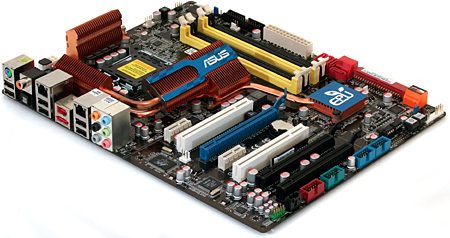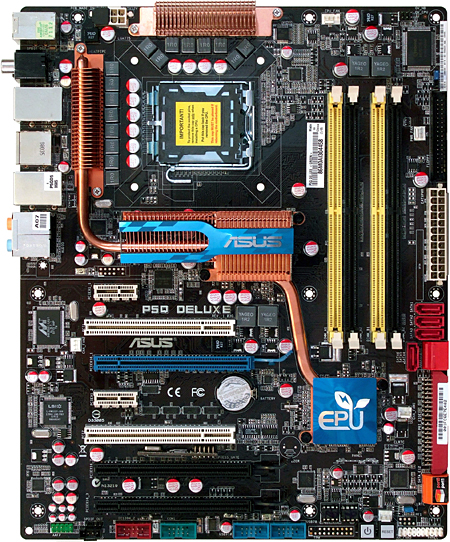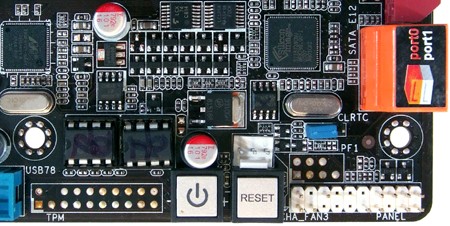11-Way P45 Motherboard Shootout
Asus P5Q Deluxe
Asus fans looking for better value in a high-end motherboard might consider the P5Q Deluxe. A Web price of around $200 gets buyers all the major features of the more expensive Maximus II Formula but far less bling.
Some users might even say that the P5Q Deluxe has more features than the Maximus II Formula, with a third PCI Express x16 graphics card slot and the “Asus Express Gate” SSD which comes pre-loaded with the Splashtop OS. But a few minor features are lost.
For example, the same AD2000BX audio codec is used, but it’s located onboard rather than on a riser card. P5Q Deluxe owners get back a slot this way, since the top PCI Express x1 slot is no longer serving as a chipset link for the codec card. And the gain of a third PCI Express x16 slot isn’t anything to brag about either, since the slot is limited to a maximum of x4 transfers and will drop to x1 mode if any of the other x1 slots are occupied.
The two PCI Express 2.0 slots still share 16 pathways, automatically switching between one by x16 or two by x8 modes depending on the number of cards installed, and other features that bolster the Maximus II Formula’s specifications, such as its sixteen-phase CPU voltage regulator and dual BIOS chips, can also be seen on the P5Q Deluxe.
The power and reset buttons still light up, although not in the showy way of the P5Q Deluxe’ more expensive sibling, and the same third-party SATA/Ultra ATA controller serves the same functions.
The P5Q Deluxe loses nothing to the Maximus II Formula in layout, with its memory slots being mounted too low being forgivable, since it allows shorter pathways to the northbridge for added high-speed stability. The primary PCI Express x16 slot has been moved southward in the same manner, to make extra room for DIMM latch clearance, with a PCI Express x1 and a legacy PCI slot above it. The biggest “unsolvable” issue with having the two major x16 slots located so far towards the bottom of the motherboard is that the third slot will become unusable if two graphics cards with double-thick coolers are installed.
Four of the eight internal Serial ATA connectors face forward, which will prevent them being used whenever an ATX chassis has a drive bay in close proximity to the motherboard’s front edge, but the four outward-facing ports have no such issues. One of the outward facing ports may however be blocked by the end of a long graphics card.
Get Tom's Hardware's best news and in-depth reviews, straight to your inbox.
Located near the bottom of the motherboard’s front edge, anyone using the Ultra ATA connector may find it impossible to stretch the cable to the upper bay of taller cases. We sincerely believe that the majority of high-end builders won’t need Ultra ATA anyway.
The floppy connector has become slightly more important as many gamers cling to Windows XP, which requires a floppy drive for installing AHCI or RAID drivers. Asus had carefully considered this software issue, and has placed the cable header directly behind the typical location of an ATX tower’s 3.5” external bays.
Our constant complaint about front panel connectors being placde in the bottom rear corner applies to the FP audio header of the P5Q Deluxe, as the cables of some cases simply won’t reach that far. The Maximus II Formula had avoided the audio problem by putting this connector on a riser card, but instead had an IEEE-1394 FireWire port in the same location. Asus moved the P5Q Deluxe’ FireWire port slightly forward, easing, but not eliminating, the data connector issue.
Current page: Asus P5Q Deluxe
Prev Page Maximus II Formula Software And Accessories Next Page P5Q Deluxe Onboard Devices-
nickchalk Where are the lower price P45 M/B ?Reply
Asus P5Q pro is out for €110 and P5Q deluxe for €165 the price difference is about 70$ in Greece. -
Proximon I suppose I can get some good from having read this. Did you get paid by the word? Maybe next time you could just put together a complete features chart so that we can have some convenient comparison? You know, so someone could go to a chart and see at a glance which boards had eSATA or firewire, or 8 USB.Reply
-
JPForums I'd rather have the overabundance of information than a lack of information. Presentation could use a little refining (I.E. comparison charts and the likes), but having the relevant information available at least is a good thing.Reply -
the introduction and specifics are nice, the comparision isn't. so, why don't you test with an 8500 or qx9650? 6850 are outdated... and a mobo handling a c2d doesn't mean it can handle a quad too, see P5K for example (it stinks when it comes to a q6600).Reply
-
Crashman procithe introduction and specifics are nice, the comparision isn't. so, why don't you test with an 8500 or qx9650? 6850 are outdated... and a mobo handling a c2d doesn't mean it can handle a quad too, see P5K for example (it stinks when it comes to a q6600).Reply
Tom's Hardware wants the performance of current articles to reflect that of recent articles, so a "standard test platform" was chosen a while ago. It will get updated, but probably not before the new socket becomes widely available. -
zenmaster I would have liked to see something such as a P35 and an X48 as controls to help analyze the P45 Performance.Reply
In otherwords, What is the P45 Gaining me over the older P35.
What would I gain by going to the X48. (Or Lose) -
Crashman zenmasterI would have liked to see something such as a P35 and an X48 as controls to help analyze the P45 Performance.In otherwords, What is the P45 Gaining me over the older P35.What would I gain by going to the X48. (Or Lose)http://www.tomshardware.com/reviews/intel-p45-chipset,1961.htmlReply -
johnbilicki The first 17 pages were filled with nothing but junk from ASUS. Do us a favor: don't even bother featuring or *MENTIONING* anything for any reason from a company that refuses to RMA 200-400 dollar brand new motherboards with anything other then used and usually broken junk. It destroyed my enthusiasm for the article.Reply -
dobby nickchalkWhere are the lower price P45 M/B ?Asus P5Q pro is out for €110 and P5Q deluxe for €165 the price difference is about 70$ in Greece.Reply
the p5q PRo is a p43 board, i should know i have one



